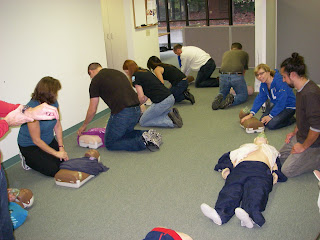14 October 2012
13 of us attended a pilot project in which the Woodinville Fire District folks taught us First Aid and CPR(AED) classes - and we earned our certification cards!! This class developed as I had attended a Cascade Cycle Club event earlier in 2012 (I think) on First Aid and, while the instructor seemed capable, we didn't actually follow a curriculum, kind of wandered around on eclectic topics, and lastly had way too many people in the available room size to meaningfully practice items I discovered that our local Fire District does offer these classes and would schedule a special session for a group - so selectively using our email list, I invited some folks from there who are (or could be) Ride Leaders from our group and put a general notice on Facebook to a Cascade Bicycle Club Rider Leader page - we got only two from the RL page and the rest from our own little group.
Dave Weed (Woodinville Fire District Community Education Officer and a National Instructor on this topic) did the instruction and, in my opinion, was a fabulous teacher for this topic. We really focused on what you needed to know and do as a first responder and he made extensive use of bicycle riding examples. The CPR process has been greatly updated and simplified so that it is much easier to do. Interesting statistics show that on the average, the national survival rate for people who have heart attacks and need 911 assistance is about 10% (ie people who are ultimately released from the hospital) but here in King County the percentage survival is about 52%! Since the EMT and ER responses are about the same, the difference is that in our area we have had a major push to educate citizens to perform enough CPR methodologies to keep people alive (or as was described "keep people from being completely dead") until the EMT's can arrive which is about 6 min 13 sec on average! The hands on exercises were revealing on just how hard it is to keep doing the compression chest moves for multiple minutes - everyone was feeling it after only two minutes! It is important to use a team approach to have someone call 911, someone do chest compressions, someone manage traffic etc at the scene etc. ....and just maybe you will need to have someone take turns with you doing the chest compressions!
Here we are practicing saving lives of our dummies!
It turns out you need to get to bare skin on the chest and thus have to remove all clothing from the chest area. While we were told it was not a time in which modesty was a factor, I think you want to be pretty sure the person really needs CPR before taking her clothes off - I'm not sure if you could mount a credible defense if the person was just dozing and you decided that CPR was needed.......
We also went on to use the Automated Emergency Defibrillator (AED) - pretty simple and very sophisticated - common in many buildings these days! You still start with CPR and then go to the AED if chest compressions and breath assistance doesn't work.
Dave showed us how to apply the electrodes which actually don't start the heart per se but actually stop it to that the internal heart pumping trigger mechanism can regain control of a heart undergoing fibrillation.
After placement of the electrodes, you need to stand clear else you will get the shock too!! Although I will say this picture might lead someone to think we are administering last rites to the dummy......but this team is awaiting the electrical shock by the AED - and the dummy did survive! I am thinking of nominating this team for sainthood as this could be the first of the three required miracles....
We subsequently covered First Aid and the various conditions particularly those we might encounter on bike rides. In particular, Dave made a strong emphasis on differentiating between "sick" (ie conditions in which you might not survive an hour) versus "not sick" (ie conditions in which immediacy is not as paramount although it can still be painful, eg a broken arm) - these are key to understanding the specific steps you need to take and your role as the first responder.
This was a really great way to spend a rainy Sunday morning and I hope the other attendees got as much out of this as I did! I would certainly recommend these kinds of classes if you can find instructors who are engaging and very knowledgeable about what you should do from a practical perspective and if you can find instructors who understand bicycling and related athletic sport activities. I am now the proud holder of a certificate card - and while the card doesn't mean much per se, it does represent the awareness and perspectives that I now have if I have to be a first responder. It is something I hope to come up for renewal in 2014 without ever having had to use the knowledge gained.
Ride carefully out there folks. You really don't want me to have to be your first responder.





No comments:
Post a Comment